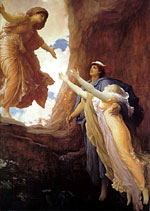
Ancient Springtime Celebrations
Long before Jesus walked on the earth,
people celebrated when spring arrived. Many of Easter's interesting and
often unusual customs began hundreds, even thousands of years ago during
the spring! In ancient times, people did not know why the seasons changed.
They thought spirits or gods and goddesses guided the times of the
seasons. Some even thought the sun died when winter came! When spring
arrived, they were happy to see plants blooming, animals coming out of
hibernation, and birds returning from far away. These ancient people
expressed their joy in the arrival of spring with many different
celebrations.
The Celts lived in what is now
the greater part of western Europe, mainly from 2000 B.C. to 100 B.C.
Their religion was called Druidism, and they believed in good and
evil spirits. These prehistoric people thought that winter came when evil
spirits captured the sun god. When spring began each year, the
Celts lit huge bonfires, hoping to frighten the evil spirits into
releasing the sun. In some countries today, such as Germany ,Belgium and
Russia, bonfires are still a part of Easter celebrations. The use of a
large candle in Easter services today is also traced to these ancient
customs.
The ancient Greeks believed that gods
and goddesses were in charge of the earth. A Greek story says the goddess
Demeter's daughter was kidnapped while picking flowers and
afterward was allowed to visit her mother only during the spring and
summer. When each spring arrived, the Greeks believed
Demeter's happiness made the flowers bloom. They thought her
sadness caused winter to return when her daughter went away again. The
daughter was said to have been picking narcissus when she was captured, so
it became a flower of special meaning to the Greeks. In many parts of the
world, the narcissus, with its bright and fragrant blossoms, has long been
a favorite Easter flower.
In ancient Rome, people also
thought that a goddess made the flowers bloom. They called her
Flora and held the Festival of Floralia . to honor her each
spring. During this time, Romans held big parades and carried
garlands of blossoms through the streets where statues of Flora
were lavishly decorated with flowers.
In ancient Egypt, the Hebrews were kept as
slaves, so God sent Moses to free them. When the ruler,
Pharoah, would not let the Hebrews go, God punished Egypt in
many ways. He finally sent the Angel of Death to destroy the
firstborn in each family-but first He told the Hebrews to make a
special lamb offering, and the angel would pass over their homes.
This first Passover is
commemorated each year by members of the Jewish faith, about March
21. For many years, Easter was celebrated at this same time because
Jesus was crucified during Passover.
In A.D. 325, a group of
men meeting in Nicaea, a city in what we now call Turkey, decided that
Easter should be on a different day. They chose the Sunday following
the first full moon after the vernal equinox. Vernal means
"spring," and equinox means "equal night." Thus, this
is the one 24-hour period in the spring when both day and night last
exactly twelve hours, usually on March 21 or 22.
Full moons, however, do not always come
on the same date, so Easter may fall on any Sunday between March 22 and
April 25. Sometimes it comes before Passover, and many
Orthodox or Eastern Christians wait until Passover to
celebrate Easter.
|








